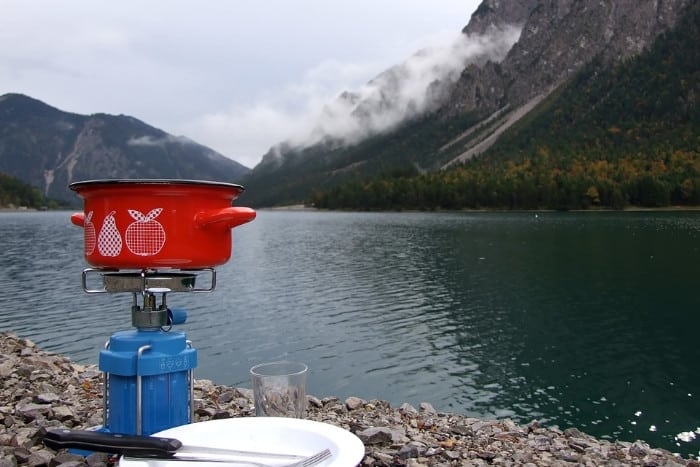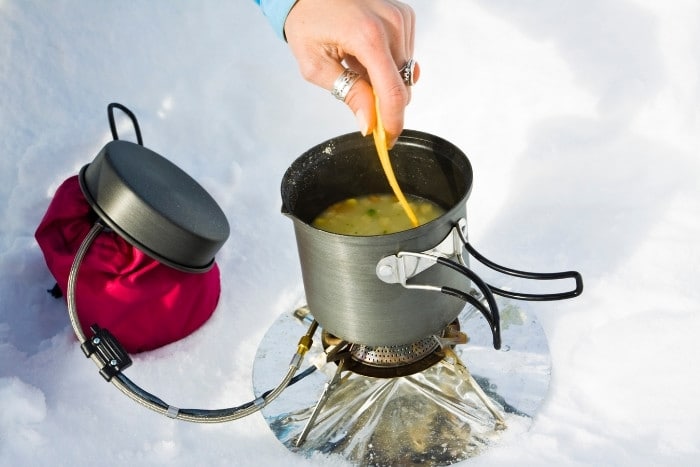A stove is a key piece of winter camping gear that campers should not go without for cold-weather trips. With so many different equipment options to choose between (from alcohol stoves to propane options to white gas stoves), it can be a challenge to figure out which may work if you are camping at low temperatures where stove functionality may be affected.
Depending on the temperatures that you are camping in, an alcohol stove can function well at temperatures just below freezing. However, in even colder conditions (below 20F), alternatives like a white gas stove will work better for more extreme cold weather conditions and longer trips.
While an alcohol stove may sound ideal, with its cheap fuel and compact size taking up limited weight and space in your pack, it may not function well for all trips. Read on to discover in what circumstances you can use an alcohol stove for cold-weather trips.
Alcohol Stoves And Winter
1. Using An Alcohol Stove In Cold Weather
Alcohol stoves are a lightweight heating option that allows you to burn the fumes that waft from the fuel, often denatured alcohol.
They are popular for those looking to travel as lightly as possible since they are compact, and sometimes weigh less than an ounce.
This can leave you with more packing room, which can be handy for extra clothes, a more durable sleeping bag, or an extra sleeping pad to keep you protected from the low temperatures.
Whereas other fuel types only need exposure to a live flame to catch fire, denatured alcohol has to be warm enough to give off the ignited fumes.
As temperatures drop, it becomes harder to light this fuel as fumes are not emitted so well at lower temperatures. Alcohol stoves may not be the most reliable option for a cold-weather trip or hike.
Naturally, the colder your fuel gets, the harder it is to start your stove.
However, as long as you remain at temperatures that do not drop below 20F, your alcohol stove should remain an effective way to get heat.
This means that for all but extreme winter or high-altitude trips, you should be able to get your alcohol stove functioning normally.

2. What Should You Do To Make Your Alcohol Stove Works Better In Cold Weather?
While alcohol stoves may not be primarily designed for cold-weather trips, there are adaptations and methods you can use that will improve your stove’s performance at lower temperatures.
Since more flammable fumes are emitted from your fuel at a higher temperature, keeping your alcohol fuel warm is key to ensuring that your alcohol stove works.
The main aim of these tips is to keep the fuel warm enough to light in the first place and to improve efficiency.
- Keep your alcohol warm. Store your fuel bottle with you when sleeping if you are camping at night after ensuring it is safely sealed. Additionally, you can carry your fuel in your coat pocket, where you can leverage your body heat to keep it warm.
- Use methanol. It works better in cold weather since it is easier to burn in cold conditions, for example, HEET (yellow bottle).
- Consider a primer to help you light your fuel more quickly and safely.
- Erect a windshield to keep heat reflected at your stove and prevent it from escaping.
- Stop heat loss and wastage by insulating your stove with a non-flammable material again.
3. When Should You Consider Other Stove Types?
Campers should be aware that the benefits of an alcohol stove can dramatically reduce depending on the length and nature of your trip.
If you are on a long winter hike, the benefits of traveling with an alcohol stove are reduced since alcohol provides less energy in proportion to its weight compared to other fuel types.
Similarly, while an alcohol stove may be just what you need to boil water for a couple of hot drinks on a day’s hiking in colder weather, it will not be powerful enough to melt snow or cook conveniently.
Hikers or campers in these situations often recommend a campfire as your primary heat source or other types of stove.
As with a longer hike, the quantity of fuel you would need to maintain this level of use outweighs the benefits of choosing an alcohol stove for its compactness.
It will also require a lot more of your time and attention than other heat source types. Finally, suppose you will likely experience extremely cold conditions lower than 20F.
In that case, a different stove type will almost certainly work better for your trip due to the limitations of alcohol as fuel in cold conditions.
4. Which other stoves work better in cold weather?
While alcohol stoves shouldn’t be ruled out for cold weather trips, outdoor experts often recommend other stove types for more extreme trips for better functionality and reliability.
Top of the list of cold-weather stove options is a white gas stove. At the same time, pressurized petrol canisters are a popular camping stove option in normal weather conditions.
White gas stoves use a hand pump to make the fuel bottle pressurized.
This means that the temperature is not important when getting your stove alight, making it the ideal choice if you are doing a more extreme trip or would need to heat more than just a couple of mugs of hot water.
As white gas stoves can be somewhat complicated to operate, another option is the inverted canister stove which also functions well in lower temperatures.
Besides extremely low temperatures below -20F, an inverted canister stove can provide a reliable heat source powerful enough to melt snow efficiently or cook a meal.

5. How to get alcohol stoves working safely
If you choose to take an alcohol stove on your trip, always be aware that, as with any heat source, there are safety issues that you should be conscious of whenever it is in use.
Since the fuel is liquid, spillage is a potential risk, so it is important to keep your fuel sealed safely when not in use and keep your stove in a secure and steady position when ignited.
The flame ignited in alcohol stoves is also almost invisible, which means that a spill can be very dangerous unless properly attended to.
The recommended course of action in case of a spill is to move away and wait for the spilled alcohol to burn off before returning.
Methanol is a recommended fuel for cold-weather trips, but produces toxic fumes that should not be inhaled, so ensure you sit upwind from your stove to avoid health complications.
Final Words
Unless you are in extremely cold conditions, you can make adaptations to ensure that your alcohol stove works on a cold-weather trip.
You should consider whether an alcohol stove is an appropriate choice for your adventure, depending on the length and the requirements of your stay or journey.
